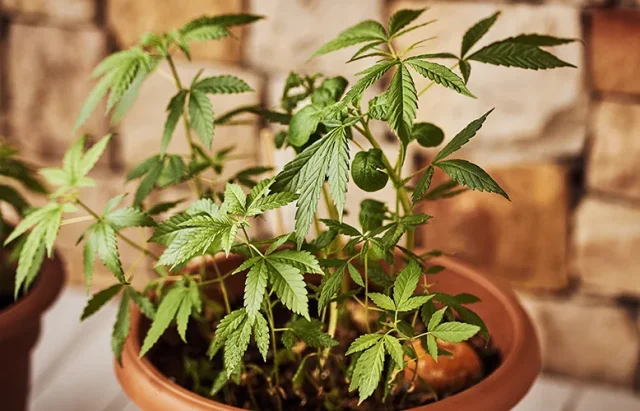
Growing cannabis can be an immensely rewarding experience, but it’s also a process that requires patience, knowledge, and preparation. Like any plant, cannabis has a unique growth cycle that demands specific care and attention at each stage. Whether you’re a beginner or have some experience, understanding the key stages in cannabis growth is essential to cultivate healthy plants and maximize yields.
This guide walks you through each stage of cannabis growth, from seedling to harvest, so you know what to expect and how to prepare at every step.
Cannabis Growth Journey: Key Stages and Essential Preparations
The cannabis growth journey involves several crucial stages, each requiring specific preparations for a successful harvest. Understanding how to grow weed through these stages—from germination to flowering—ensures a thriving plant with optimal yield potential.
1. Germination Stage (1–7 Days)
Overview: The journey of a cannabis plant begins with germination, a process where the seed sprouts and becomes a seedling. In this stage, the seed cracks open, and the root, known as the taproot, emerges.
What to Expect: During germination, cannabis seeds need moisture, warmth, and darkness to activate. Germination can take anywhere from 24 hours to 7 days, depending on seed quality and environmental conditions. When the taproot breaks through, the seed is ready to be planted.
Preparation Tips:
- Soaking Seeds: Some growers recommend soaking seeds in water for 12–24 hours to speed up germination.
- Planting Medium: Choose a planting medium that holds moisture well, such as a seedling starter or rock wool.
- Temperature: Keep the environment warm (around 70–80°F or 21–26°C) and ensure adequate moisture without over-saturating.
2. Seedling Stage (2–3 Weeks)
Overview: After germination, the seedling stage is where the cannabis plant starts developing its first leaves and roots. This period is critical for establishing a strong foundation for growth.
What to Expect: During the seedling stage, small leaves, known as cotyledons, will emerge, followed by the iconic serrated cannabis leaves. By the end of this stage, the plant should have several sets of leaves and a sturdy root system.
Preparation Tips:
- Lighting: Seedlings need around 18 hours of light per day. Keep the light source close to the plant but avoid intense heat, as it can damage the tender young leaves.
- Watering: Seedlings are prone to overwatering, so water sparingly, allowing the soil to dry out between waterings.
- Nutrients: Use a gentle nutrient solution if needed, as seedlings can be sensitive to high nutrient levels.
3. Vegetative Stage (3–8 Weeks)
Overview: The vegetative stage marks the period of rapid growth, where the cannabis plant develops its structure, branches, and leaves. During this time, the plant focuses on building size and strength to support future buds.
What to Expect: Your plant will start to grow quickly, producing more leaves and branching out. This is also when you may notice the plant’s sex (male or female), which is important if you’re growing for bud production, as only female plants produce buds.
Preparation Tips:
- Lighting: Maintain 18–24 hours of light each day, ideally using full-spectrum or blue-spectrum lights to encourage leaf and branch growth.
- Watering and Nutrients: Increase watering frequency, but still allow the soil to dry between watering. Use nitrogen-rich fertilizers, as nitrogen supports leafy growth.
- Training Techniques: Consider techniques like topping, low-stress training (LST), or pruning to promote an even canopy and maximize light exposure.
4. Pre-Flowering Stage (1–2 Weeks)
Overview: As the plant transitions from the vegetative to the flowering stage, you’ll notice signs of “pre-flowering,” which signals that the plant is preparing to produce buds.
What to Expect: Pre-flowering is when cannabis plants begin showing their sex organs. Female plants will produce tiny, hair-like pistils, while male plants produce small pollen sacs.
Preparation Tips:
- Identifying Sex: If you’re growing for buds, it’s important to identify and remove male plants, as they can pollinate females, leading to seed production instead of bud formation.
- Adjusting Nutrients: Begin reducing nitrogen and introducing a higher ratio of phosphorus and potassium to support budding.
5. Flowering Stage (6–10 Weeks)
Overview: The flowering stage is when cannabis plants begin developing buds. This is the most crucial stage for producing high-quality cannabis, as the plant shifts its energy toward bud production.
What to Expect: You’ll see significant changes during the flowering stage, with buds forming at the nodes (where branches meet the stem) and growing denser over time. The pistils on the buds will also change color, moving from white to darker shades as the plant matures.
Preparation Tips:
- Lighting: Switch to a 12/12 light cycle (12 hours of light, 12 hours of darkness) to encourage flowering. Ensure that there’s no light leak during the dark period, as this can stress the plant.
- Nutrients: Use flowering-stage nutrients, which are typically higher in phosphorus and potassium, to support bud growth.
- Humidity and Temperature: Keep humidity levels low (40–50%) to prevent mold and maintain a temperature of 65–80°F (18–26°C).
6. Harvesting Stage
Overview: The final stage is harvesting, where growers reap the fruits of their labor. Harvest timing is crucial for maximizing potency, flavor, and yield.
What to Expect: As harvest time approaches, the buds will be dense, and the pistils will have mostly turned a darker color. Trichomes, the resin glands on the buds, will change from clear to cloudy and then amber, signaling optimal harvest time.
Preparation Tips:
- Harvest Timing: Use a magnifying glass to examine trichomes for the best indicator of harvest readiness. Cloudy trichomes with a few amber ones indicate peak potency.
- Drying and Curing: After harvesting, hang the buds to dry in a dark, well-ventilated room, maintaining 45–55% humidity. Cure the dried buds in glass jars to preserve flavor and potency.
Final Thoughts
Understanding each stage of cannabis growth is key to producing a high-quality yield. From providing adequate light and nutrients to recognizing the signs of a healthy plant, each step requires thoughtful preparation and attention. By following these guidelines and preparing for each growth stage, you’ll set yourself up for a successful harvest and enjoy the rewards of growing your own cannabis.





